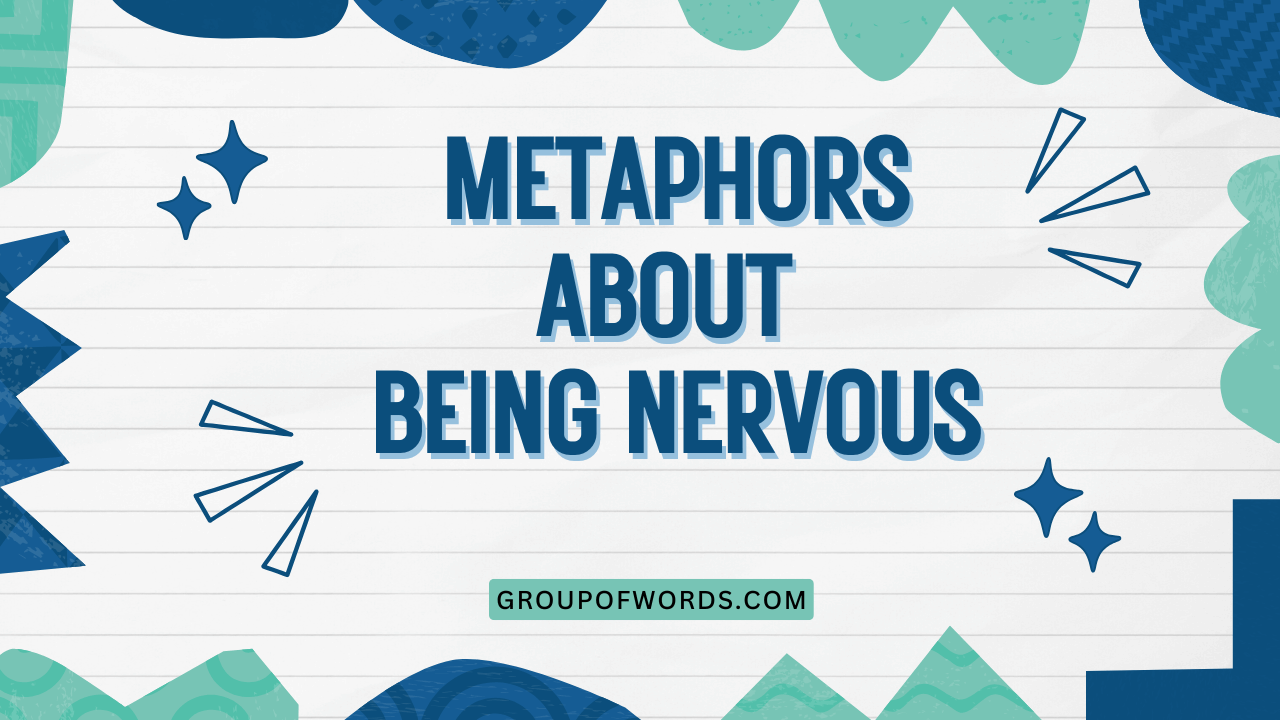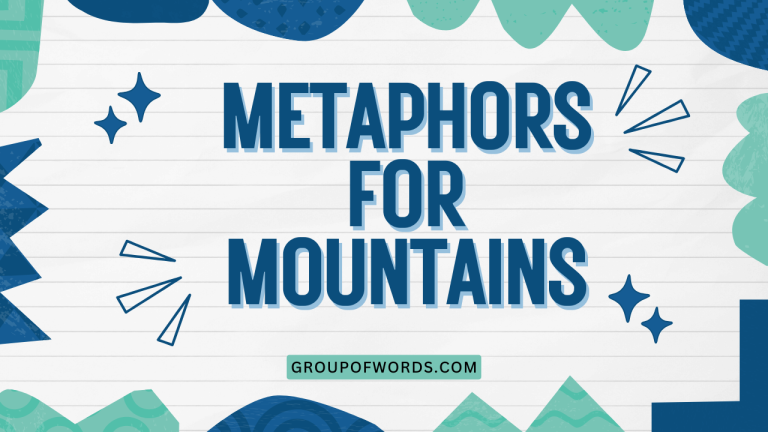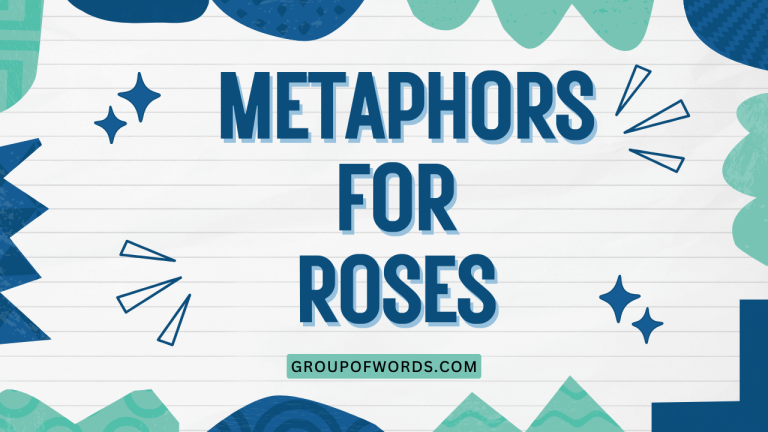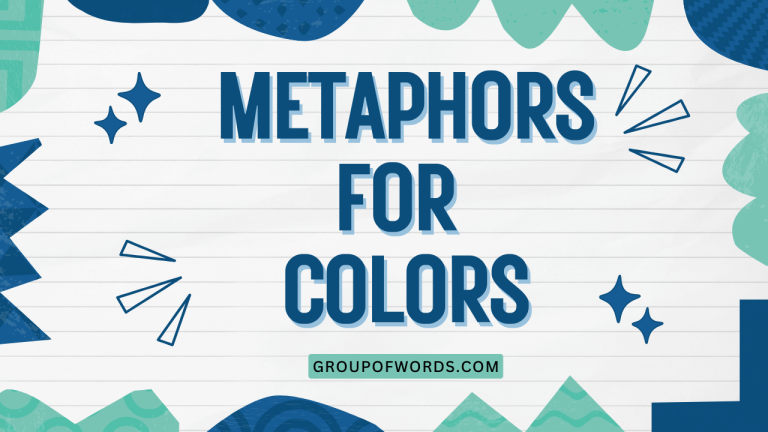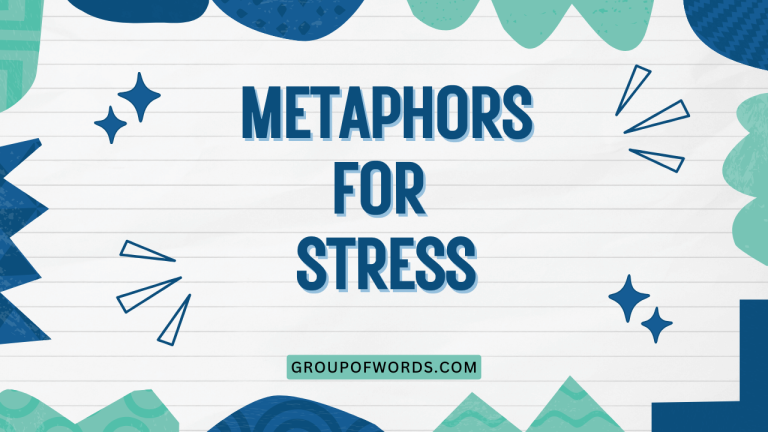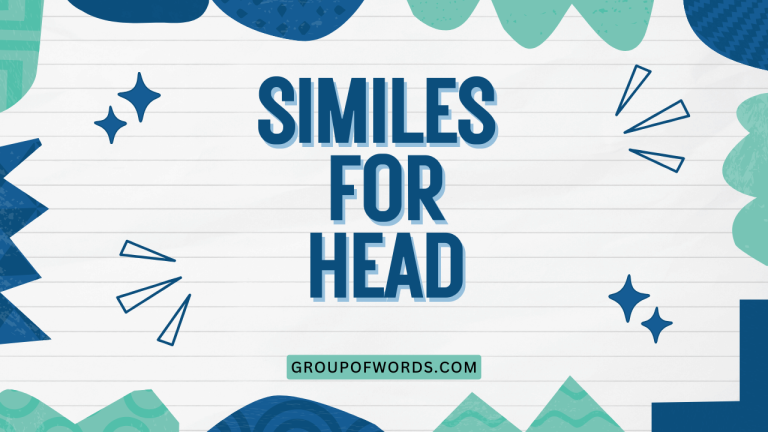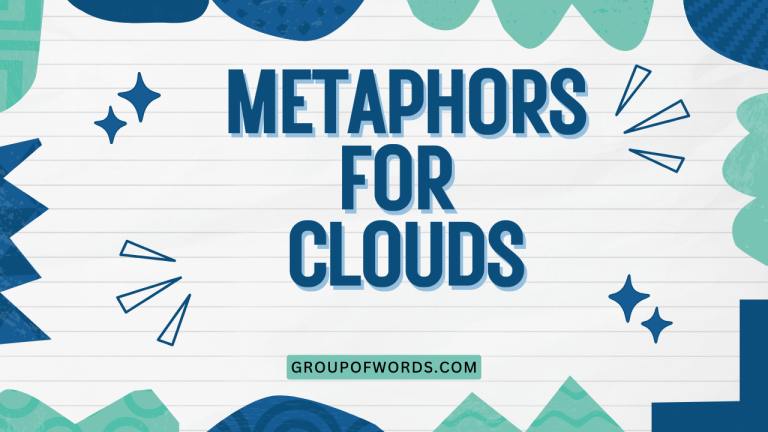Feeling the Butterflies: Mastering Metaphors for Nervousness
Nervousness is a universal human experience, and English offers a rich tapestry of metaphors to describe this feeling. Understanding these metaphors not only enhances your vocabulary but also allows you to express yourself with greater nuance and creativity.
This article explores common metaphors used to describe nervousness, dissecting their meanings, structures, and usage. Whether you’re an English language learner or a native speaker aiming to refine your communication skills, this guide will equip you with the tools to articulate your anxieties vividly and effectively.
By delving into the world of metaphorical expressions, we’ll uncover the subtle ways in which language shapes our understanding and communication of emotions. This exploration will cover everything from basic definitions and structural breakdowns to practical examples and common mistakes, ensuring a comprehensive grasp of the topic.
Get ready to transform your understanding of nervousness and the power of metaphor!
Table of Contents
- Introduction
- Definition of Metaphors for Nervousness
- Structural Breakdown
- Types and Categories of Nervousness Metaphors
- Examples of Metaphors for Nervousness
- Usage Rules
- Common Mistakes
- Practice Exercises
- Advanced Topics
- FAQ
- Conclusion
Definition of Metaphors for Nervousness
A metaphor is a figure of speech that directly compares two unlike things without using “like” or “as.” When we talk about nervousness, metaphors allow us to express the abstract feeling of anxiety through concrete, relatable images. These metaphors help us understand and communicate the often-overwhelming sensations associated with nervousness.
In the context of nervousness, a metaphor typically takes a characteristic or sensation associated with a tangible object or experience and applies it to the intangible feeling of anxiety. For example, saying “I have butterflies in my stomach” doesn’t literally mean there are insects fluttering inside you; it uses the fluttering sensation of butterflies to represent the uneasy feeling of nervousness.
The function of these metaphors is to make the internal, subjective experience of nervousness more accessible and understandable, both to ourselves and to others.
Metaphors for nervousness can be classified based on the source domain from which they draw their imagery. These domains can include physical sensations, animal behavior, natural elements, internal turmoil, and performance-related scenarios.
Each category offers a unique lens through which to view and express the feeling of nervousness.
Structural Breakdown
The basic structure of a metaphor involves two key elements: the tenor and the vehicle. The tenor is the subject being described (in this case, nervousness), and the vehicle is the object or concept used to describe it.
Consider the metaphor “My heart was racing.” The tenor is the speaker’s nervousness, and the vehicle is the racing heart. The connection between the two is the shared characteristic of rapid, uncontrolled movement.
This shared characteristic forms the basis of the metaphorical comparison.
Metaphors can also be more complex, involving extended comparisons and layers of meaning. For example, “The pressure was a vise gripping my chest” uses the image of a vise (the vehicle) to convey the feeling of intense, constricting pressure (related to the tenor of nervousness).
The structure highlights the intensity and physical manifestation of the anxiety.
Understanding the structural elements of metaphors allows for a more conscious and effective use of language. By recognizing the relationship between the tenor and the vehicle, you can create more vivid and impactful descriptions of your own experiences and understand the nuances of others’ expressions.
Types and Categories of Nervousness Metaphors
Metaphors for nervousness can be grouped into several categories based on the source of their imagery. These categories help to understand the different facets of nervousness and how they are expressed metaphorically.
Here are some common categories:
Physical Sensations
These metaphors describe nervousness through physical symptoms and sensations. They often relate to bodily reactions such as sweating, trembling, or an accelerated heartbeat.
These metaphors are very common because nervousness often manifests physically.
Animal Behavior
This category uses animal behavior to represent the feeling of nervousness. Animals known for skittishness, anxiety, or frantic energy are often used as vehicles.
For example, butterflies in your stomach or feeling like a caged animal.
Natural Elements
Metaphors in this category draw on natural phenomena like storms, earthquakes, or turbulent weather to depict the internal turmoil of nervousness. These metaphors often convey a sense of being overwhelmed or out of control.
Internal Turmoil
These metaphors focus on the internal, psychological experience of nervousness. They often describe a state of chaos, confusion, or inner conflict.
They help to illustrate the mental aspect of the feeling.
Performance-Related Metaphors
These metaphors are specifically related to situations involving performance, such as public speaking, exams, or athletic competitions. They often describe the pressure to succeed or the fear of failure.
These are often related to feeling “on stage” and being observed.
Examples of Metaphors for Nervousness
To illustrate the different types of metaphors used to describe nervousness, here are several examples categorized by their respective domains.
Physical Sensations Examples
This section provides examples of metaphors that use physical sensations to describe nervousness. These metaphors often focus on bodily reactions like sweating, trembling, or heart palpitations.
They help to convey the physical impact of anxiety.
Below is a table with examples of physical sensation metaphors:
| Metaphor | Explanation |
|---|---|
| My palms were sweating. | Expresses nervousness through the physical symptom of sweaty palms. |
| My heart was pounding in my chest. | Describes the feeling of a rapidly beating heart due to anxiety. |
| I felt a lump in my throat. | Indicates nervousness making it difficult to speak. |
| My hands were trembling. | Conveys the physical shaking associated with nervousness. |
| I had a knot in my stomach. | Describes the feeling of tension and unease in the stomach. |
| My legs felt like jelly. | Expresses the feeling of weakness and instability due to nervousness. |
| I felt a cold sweat break out on my forehead. | Describes the physical sensation of cold sweat caused by anxiety. |
| My voice was shaking. | Conveys the instability in one’s voice due to nervousness. |
| I felt lightheaded. | Describes the sensation of dizziness caused by anxiety. |
| My breathing became shallow. | Indicates rapid and insufficient breathing due to nervousness. |
| My face flushed red. | Describes the physical symptom of blushing due to nervousness. |
| I felt a tingling sensation in my fingers. | Expresses the sensation of pins and needles caused by anxiety. |
| My muscles were tense. | Conveys the physical tension in one’s muscles due to nervousness. |
| I felt a wave of nausea. | Describes the sensation of feeling sick to one’s stomach due to anxiety. |
| My throat was dry. | Indicates dryness in the throat caused by nervousness. |
| My stomach was in knots. | Similar to “a knot in my stomach,” emphasizing the tightness and discomfort. |
| I felt pins and needles all over. | An amplified version of tingling, suggesting widespread anxiety. |
| My skin crawled. | A visceral reaction, indicating extreme unease or anxiety. |
| I could feel my pulse throbbing in my ears. | Highlights the heightened awareness of physical sensations due to nervousness. |
| My teeth were chattering. | Describes uncontrollable shaking due to fear or anxiety. |
| My vision blurred. | Indicates a physical symptom of extreme stress or panic. |
| I felt a pressure building in my head. | Describes the sensation of mounting tension and stress. |
| My jaw was clenched. | Conveys the physical tension held in the jaw muscles due to stress. |
| My shoulders were tight. | Similar to a clenched jaw, showing how stress manifests in muscle tension. |
| I felt a surge of adrenaline. | Recognizes the body’s fight-or-flight response to a stressful situation. |
Animal Behavior Examples
This section provides examples of metaphors that use animal behavior to describe nervousness. These metaphors often draw on the characteristics of animals known for being skittish, anxious, or frantic.
They help to convey the feeling of restlessness and unease.
Here’s a table showcasing metaphors based on animal behavior:
| Metaphor | Explanation |
|---|---|
| I had butterflies in my stomach. | Describes the fluttering sensation of nervousness in the stomach. |
| I felt like a caged animal. | Expresses the feeling of being trapped and restless due to anxiety. |
| I was as nervous as a long-tailed cat in a room full of rocking chairs. | A humorous expression suggesting extreme nervousness and potential for mishap. |
| I felt like a deer in headlights. | Describes the feeling of being frozen and overwhelmed by fear. |
| I was as jittery as a hummingbird. | Conveys the feeling of being restless and constantly moving due to nervousness. |
| I felt like a fish out of water. | Expresses the feeling of being uncomfortable and out of place. |
| I was as timid as a mouse. | Describes the feeling of being shy and easily frightened. |
| I felt like a scared rabbit. | Conveys the feeling of being easily startled and wanting to flee. |
| I was as jumpy as a frog on a hot plate. | A vivid description of extreme nervousness and restlessness. |
| I felt like a bird with a broken wing. | Expresses the feeling of being vulnerable and unable to perform. |
| I was as skittish as a wild horse. | Describes the feeling of being easily spooked and difficult to control. |
| I felt like a cornered rat. | Conveys the feeling of being trapped and desperate. |
| I was as anxious as a cat in a dog pound. | Describes the feeling of being surrounded by danger and discomfort. |
| I felt like a lamb to the slaughter. | Expresses the feeling of impending doom and helplessness. |
| I was as restless as a caged tiger. | Conveys the feeling of being trapped and full of pent-up energy. |
| My mind was racing like a hamster on a wheel. | Describes repetitive, unproductive thoughts fueled by anxiety. |
| I felt like a swarm of bees was buzzing in my head. | Illustrates chaotic, overwhelming thoughts. |
| I was sweating like a pig. | A common, albeit somewhat crude, way to describe excessive sweating due to nervousness. |
| I felt like a trapped butterfly, desperate to escape. | A variation on “butterflies in the stomach,” adding a sense of urgency and panic. |
| I was as quiet as a mouse. | Describes being meek and reserved due to fear or nervousness. |
| I felt like I was herding cats. | Captures the feeling of trying to manage chaotic thoughts or situations. |
| I felt like a snake about to shed its skin. | Describes a feeling of vulnerability and transformation. |
| I was pacing like a lion in a zoo. | Conveys restlessness and pent-up energy. |
| I was as busy as a bee. | Describes a state of frantic, nervous activity to avoid facing the situation. |
| I felt like a worm squirming on a hook. | Conveys a feeling of helplessness and discomfort. |
Natural Elements Examples
This section provides examples of metaphors that use natural elements to describe nervousness. These metaphors often draw on the power and unpredictability of natural phenomena like storms, earthquakes, or turbulent weather.
They help to convey the feeling of being overwhelmed and out of control.
Here’s a table with metaphors drawing from natural elements:
| Metaphor | Explanation |
|---|---|
| I felt like I was walking on thin ice. | Describes the feeling of being in a precarious and risky situation. |
| My mind was a stormy sea. | Expresses the feeling of turbulent and chaotic thoughts. |
| I felt like I was drowning in anxiety. | Conveys the feeling of being overwhelmed and suffocated by nervousness. |
| The pressure felt like an earthquake. | Describes the feeling of intense and overwhelming stress. |
| My thoughts were racing like a wild river. | Expresses the feeling of uncontrolled and rapid thinking. |
| I felt like I was standing on shaky ground. | Describes the feeling of being insecure and uncertain. |
| My emotions were a volcano about to erupt. | Conveys the feeling of suppressed anger and anxiety. |
| I felt like I was lost in a fog. | Expresses the feeling of confusion and disorientation. |
| The tension was as thick as molasses. | Describes the feeling of heavy and oppressive stress. |
| I felt like I was being swept away by a tidal wave of anxiety. | Conveys the feeling of being completely overwhelmed. |
| My fears were like dark clouds gathering overhead. | Expresses the feeling of impending doom and anxiety. |
| I felt like I was caught in a whirlwind of emotions. | Describes the feeling of being disoriented and out of control. |
| The pressure was a mountain I couldn’t climb. | Conveys the feeling of an insurmountable challenge. |
| My anxiety was a deep, dark forest. | Expresses the feeling of being lost and afraid. |
| I felt like I was sinking in quicksand. | Describes the feeling of being trapped and helpless. |
| My thoughts were a tangled forest. | Describes confusion and difficulty in processing thoughts. |
| The silence was a heavy blanket. | Conveys the oppressive feeling of anticipation and dread. |
| Nervousness washed over me like a cold wave. | Describes a sudden, overwhelming feeling of anxiety. |
| The anticipation was a slow-burning fire. | Illustrates prolonged, simmering anxiety. |
| The uncertainty hung in the air like a thick fog. | Conveys a sense of unease and lack of clarity. |
| My courage had dried up like a barren desert. | Describes a loss of confidence and bravery. |
| The challenge loomed like a towering glacier. | Illustrates an imposing and seemingly insurmountable obstacle. |
| Fear gripped me like a frozen tundra. | Conveys a sense of being paralyzed by fear and anxiety. |
| My hope dwindled like a fading sunset. | Describes a gradual loss of optimism. |
| My confidence crumbled like a sandcastle. | Illustrates a sudden and complete loss of self-assurance. |
Internal Turmoil Examples
This section provides examples of metaphors that focus on the internal, psychological experience of nervousness. These metaphors often describe a state of chaos, confusion, or inner conflict.
They help to illustrate the mental aspect of the feeling.
Here’s a table with metaphors focusing on internal turmoil:
| Metaphor | Explanation |
|---|---|
| My mind was a battlefield. | Expresses the feeling of internal conflict and mental struggle. |
| I felt like I was coming apart at the seams. | Describes the feeling of being overwhelmed and losing control. |
| My thoughts were a jumbled mess. | Conveys the feeling of confusion and disorganization. |
| I felt like I was losing my mind. | Expresses the feeling of being overwhelmed and irrational. |
| My emotions were a roller coaster. | Describes the feeling of unpredictable and intense mood swings. |
| I felt like I was trapped in a maze. | Conveys the feeling of being lost and unable to find a solution. |
| My thoughts were spinning out of control. | Expresses the feeling of being unable to stop racing thoughts. |
| I felt like I was walking a tightrope. | Describes the feeling of being in a precarious and risky situation. |
| My mind was a runaway train. | Conveys the feeling of thoughts moving too fast to control. |
| I felt like I was on the edge of a nervous breakdown. | Expresses the feeling of being close to losing control. |
| My anxiety was a heavy weight on my chest. | Describes the feeling of oppressive stress and worry. |
| I felt like I was drowning in my own thoughts. | Conveys the feeling of being overwhelmed by negative thinking. |
| My mind was a tangled web. | Expresses the feeling of confusion and complexity. |
| I felt like I was being torn in two. | Describes the feeling of internal conflict and indecision. |
| My thoughts were a swarm of bees. | Conveys the feeling of chaotic and overwhelming thoughts. |
| My stomach churned with worry. | Describes the physical sensation of anxiety. |
| I was wrestling with my conscience. | Illustrates internal moral conflict. |
| My head was swimming with thoughts. | Conveys a feeling of confusion and disorientation. |
| I felt like I was losing my grip. | Describes a sense of losing control over one’s emotions. |
| My heart ached with anxiety. | Illustrates deep emotional distress. |
| I was battling my inner demons. | Describes a struggle with personal fears and insecurities. |
| My thoughts were a whirlwind of confusion. | Conveys a sense of mental chaos and disarray. |
| I felt like I was unraveling. | Describes a gradual breakdown of emotional stability. |
| My mind was a pressure cooker. | Illustrates the buildup of stress and tension. |
| I felt like I was walking on eggshells. | Describes a state of extreme caution and sensitivity. |
Performance-Related Examples
This section provides examples of metaphors that are specifically related to situations involving performance, such as public speaking, exams, or athletic competitions. These metaphors often describe the pressure to succeed or the fear of failure.
Here’s a table with performance-related metaphors:
| Metaphor | Explanation |
|---|---|
| I felt like I was under a microscope. | Describes the feeling of being scrutinized and judged. |
| The stage felt like a trap. | Expresses the feeling of being confined and vulnerable. |
| My mind went blank. | Conveys the feeling of being unable to remember anything. |
| I choked under the pressure. | Describes the feeling of failing due to stress. |
| I froze on stage. | Expresses the feeling of being unable to move or speak. |
| The spotlight felt like a burning flame. | Describes the feeling of intense pressure and scrutiny. |
| My performance was a train wreck. | Conveys the feeling of a complete and utter failure. |
| I felt like I was walking a tightrope without a net. | Describes the feeling of being in a risky situation with no backup. |
| The audience felt like a sea of judging eyes. | Expresses the feeling of being intensely scrutinized. |
| My confidence crumbled under the pressure. | Describes the feeling of losing self-assurance due to stress. |
| I felt like I was running a marathon with no finish line. | Conveys the feeling of endless and exhausting effort. |
| The exam felt like a battle. | Expresses the feeling of a difficult and stressful challenge. |
| My preparation felt like a house of cards. | Describes the feeling of being inadequately prepared. |
| I felt like I was swimming against the tide. | Conveys the feeling of struggling against overwhelming odds. |
| The pressure was a vise squeezing my brain. | Describes the feeling of intense mental stress. |
| My composure shattered like glass. | Describes a sudden loss of self-control. |
| The weight of expectation crushed me. | Conveys the feeling of being overwhelmed by pressure. |
| I felt like I was walking into the lion’s den. | Describes entering a situation perceived as dangerous or hostile. |
| My voice deserted me. | Illustrates the inability to speak due to nervousness. |
| I felt like I was performing open-heart surgery on stage. | Exaggerates the feeling of intense pressure and potential for failure. |
| I was walking a tightrope over a pit of despair. | Describes a precarious situation with severe consequences for failure. |
| My courage evaporated like morning mist. | Conveys a rapid loss of bravery. |
| The audience’s silence was a deafening roar. | Describes the overwhelming pressure of performing before a silent crowd. |
| I felt like I was climbing Mount Everest barefoot. | Illustrates a daunting task with inadequate preparation. |
| My hopes were pinned to a fragile thread. | Conveys the precariousness of a desired outcome. |
Usage Rules
When using metaphors for nervousness, it’s important to consider the context and audience. A metaphor that is effective in one situation may be inappropriate in another.
Here are some general guidelines:
- Clarity: Choose metaphors that are easily understood and relatable. Avoid obscure or overly complex comparisons.
- Appropriateness: Consider the tone and formality of the situation. Humorous or informal metaphors may not be suitable for professional settings.
- Consistency: Avoid mixing metaphors within the same sentence or paragraph. This can create confusion and weaken the impact of your writing.
- Originality: While common metaphors can be effective, try to create your own unique comparisons to add originality and impact to your writing.
- Cultural Sensitivity: Be aware that some metaphors may have different connotations or meanings in different cultures.
For example, using the metaphor “I felt like I was walking on thin ice” is generally understood to mean that you are in a precarious situation. However, using a more obscure metaphor like “I felt like I was navigating the Labyrinth of Knossos” might not be as effective unless your audience is familiar with Greek mythology.
Common Mistakes
Here are some common mistakes to avoid when using metaphors for nervousness:
- Mixed Metaphors: Combining metaphors that don’t logically fit together.
- Incorrect: “I felt like I was drowning in butterflies.” (Mixing drowning and butterflies)
- Correct: “I had butterflies in my stomach.” or “I felt like I was drowning in anxiety.”
- Clichés: Overusing tired and unoriginal metaphors.
- Avoid: “Butterflies in my stomach” (Use sparingly, or find a more original alternative)
- Better: “I felt a flutter of unease deep in my gut.”
- Inappropriate Tone: Using metaphors that are too casual or humorous for the situation.
- Inappropriate: Describing a serious anxiety attack with a lighthearted metaphor.
- Appropriate: Using more intense and serious metaphors to reflect the severity of the situation.
- Overly Complex Metaphors: Using metaphors that are too difficult for your audience to understand.
- Unclear: “My anxiety felt like quantum entanglement.”
- Clearer: “My anxiety made me feel disconnected from reality.”
By being aware of these common mistakes, you can use metaphors more effectively and avoid miscommunication.
Practice Exercises
Test your understanding of metaphors for nervousness with these exercises.
Exercise 1: Identifying Metaphors
Identify the metaphors used to describe nervousness in the following sentences.
| Question | Answer |
|---|---|
| 1. My heart was pounding like a drum. | pounding like a drum |
| 2. She felt like she was walking on thin ice. | walking on thin ice |
| 3. His mind was a stormy sea. | stormy sea |
| 4. The pressure was a mountain he couldn’t climb. | a mountain he couldn’t climb |
| 5. I had butterflies in my stomach before the presentation. | butterflies in my stomach |
| 6. The stage felt like a trap. | like a trap |
| 7. My thoughts were a jumbled mess. | a jumbled mess |
| 8. I felt like I was drowning in anxiety. | drowning in anxiety |
| 9. His legs felt like jelly. | felt like jelly |
| 10. She was as nervous as a long-tailed cat in a room full of rocking chairs. | as nervous as a long-tailed cat in a room full of rocking chairs |
Exercise 2: Completing the Metaphor
Complete the following metaphors to describe nervousness.
| Question | Answer |
|---|---|
| 1. My mind was racing like a __________. | My mind was racing like a runaway train. |
| 2. I felt like I was walking __________. | I felt like I was walking a tightrope. |
| 3. The silence was as heavy as __________. | The silence was as heavy as a tombstone. |
| 4. My courage had dried up like __________. | My courage had dried up like a barren desert. |
| 5. Fear gripped me like __________. | Fear gripped me like a frozen tundra. |
| 6. My composure shattered like __________. | My composure shattered like glass. |
| 7. My hopes were pinned to __________. | My hopes were pinned to a fragile thread. |
| 8. My anxiety was a __________. | My anxiety was a deep, dark forest. |
| 9. I was pacing like __________. | I was pacing like a lion in a cage. |
| 10. The pressure was a __________. | The pressure was a vise. |
Exercise 3: Using Metaphors in Sentences
Write sentences using the following metaphors to describe a situation where someone is nervous.
| Metaphor | Example Sentence |
|---|---|
| Butterflies in my stomach | Before going on stage, the actor had butterflies in his stomach. |
| Walking on thin ice | He knew he was walking on thin ice when he confronted his boss about the issue. |
| Stormy sea | Her mind was a stormy sea of worries as she awaited the test results. |
| Runaway train | His thoughts were like a runaway train, impossible to stop before the interview. |
| Heavy weight | The responsibility of leading the project felt like a heavy weight on her shoulders. |
| Lion’s den | Entering the boardroom to give the presentation felt like walking into the lion’s den. |
| Walking a tightrope | Negotiating the contract felt like walking a tightrope, one wrong step could ruin everything. |
| Crumbled like glass | Her confidence crumbled like glass when she forgot her lines on stage. |
| Drowning in my thoughts | He was drowning in his thoughts, unable to focus on the task at hand. |
| Trapped in a maze | She felt trapped in a maze of doubts and fears about her future. |
Advanced Topics
For advanced learners, consider exploring the following:
- Extended Metaphors: Develop a single metaphor over an entire paragraph or essay for a more profound effect.
- Subtle Metaphors: Use metaphors implicitly, without explicitly stating a comparison.
- Cultural Variations
: Investigate how different cultures use unique metaphors to describe nervousness.
- Personal Metaphors: Create your own personalized metaphors that resonate with your individual experiences of nervousness.
By delving deeper into these advanced topics, you can further refine your understanding and use of metaphors for nervousness, adding depth and sophistication to your communication.
FAQ
Why use metaphors to describe nervousness?
Metaphors provide a vivid and relatable way to express the often-abstract feeling of nervousness. They help to convey the intensity and nuances of anxiety in a way that is both understandable and engaging.
How can I come up with original metaphors for nervousness?
Think about your personal experiences of nervousness and the sensations associated with it. Consider drawing comparisons to familiar objects, animals, or natural phenomena that evoke similar feelings.
Are some metaphors for nervousness better than others?
The effectiveness of a metaphor depends on the context, audience, and the specific nuance you want to convey. Some metaphors may be more appropriate in certain situations than others.
Clarity and relevance are key.
How do I avoid using clichés when describing nervousness?
Try to think outside the box and come up with fresh and original comparisons. Instead of relying on overused metaphors, focus on creating unique images that capture the essence of your experience.
Can metaphors for nervousness be used in professional settings?
Yes, but it’s important to choose metaphors that are appropriate for the tone and formality of the situation. Avoid using overly casual or humorous metaphors in professional contexts.
Conclusion
Mastering metaphors for nervousness is a valuable skill that can enhance your communication and self-expression. By understanding the structure, types, and usage rules of these metaphors, you can articulate your anxieties with greater clarity and impact.
Whether you’re a student, writer, or simply someone looking to improve your communication skills, this guide provides the tools and knowledge you need to navigate the world of metaphorical language effectively. So go ahead, embrace the power of metaphor, and let your words paint a vivid picture of your experiences!
